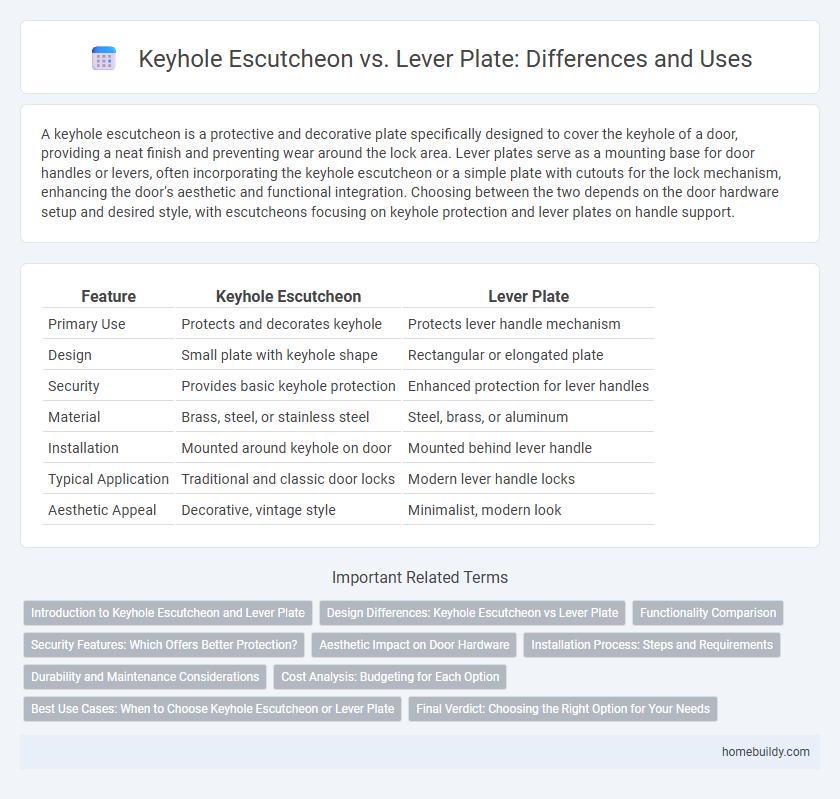A keyhole escutcheon is a protective and decorative plate specifically designed to cover the keyhole of a door, providing a neat finish and preventing wear around the lock area. Lever plates serve as a mounting base for door handles or levers, often incorporating the keyhole escutcheon or a simple plate with cutouts for the lock mechanism, enhancing the door's aesthetic and functional integration. Choosing between the two depends on the door hardware setup and desired style, with escutcheons focusing on keyhole protection and lever plates on handle support.
Table of Comparison
| Feature | Keyhole Escutcheon | Lever Plate |
|---|---|---|
| Primary Use | Protects and decorates keyhole | Protects lever handle mechanism |
| Design | Small plate with keyhole shape | Rectangular or elongated plate |
| Security | Provides basic keyhole protection | Enhanced protection for lever handles |
| Material | Brass, steel, or stainless steel | Steel, brass, or aluminum |
| Installation | Mounted around keyhole on door | Mounted behind lever handle |
| Typical Application | Traditional and classic door locks | Modern lever handle locks |
| Aesthetic Appeal | Decorative, vintage style | Minimalist, modern look |
Introduction to Keyhole Escutcheon and Lever Plate
Keyhole escutcheons are protective and decorative metal plates designed specifically to surround and reinforce keyholes on doors, enhancing security and preventing wear. Lever plates serve a similar function but are crafted to accommodate lever handles, providing both a grip surface and an aesthetic finish around the handle mechanism. Choosing between a keyhole escutcheon and a lever plate depends on door hardware compatibility and security needs.
Design Differences: Keyhole Escutcheon vs Lever Plate
Keyhole escutcheons feature a minimalist design, typically shaped to precisely cover the keyhole, providing a discreet and functional aesthetic. Lever plates are larger and often rectangular, designed to accommodate lever handles and may include additional decorative elements or integrated backplates for enhanced grip and style. The keyhole escutcheon prioritizes key access visibility, whereas the lever plate emphasizes ergonomic handle support and visual presence on doors.
Functionality Comparison
Keyhole escutcheons primarily serve as protective covers for keyholes, enhancing security by preventing tampering and debris entry while maintaining a streamlined appearance. Lever plates, in contrast, provide a broader surface that facilitates easier operation of door levers and often integrate additional locking mechanisms or aesthetic features. Functionality-wise, keyhole escutcheons focus on safeguarding the locking cylinder, whereas lever plates optimize user interaction with door hardware through ergonomic design and multifunctional capabilities.
Security Features: Which Offers Better Protection?
Keyhole escutcheons provide enhanced security by covering the keyhole to prevent tampering and drilling, making them harder to manipulate compared to lever plates. Lever plates primarily protect the lever mechanism but often leave the keyhole exposed, which can be vulnerable to lock picking or forced entry. For maximum protection against unauthorized access, keyhole escutcheons are generally considered superior due to their robust shielding of the lock cylinder.
Aesthetic Impact on Door Hardware
Keyhole escutcheons provide a classic, refined aesthetic that enhances traditional door hardware, emphasizing intricate detailing and subtle elegance. Lever plates offer a more modern and sleek appearance, often favored for minimalist or contemporary design schemes with clean lines. The choice between keyhole escutcheon and lever plate significantly influences the visual harmony and style coherence of door hardware installations.
Installation Process: Steps and Requirements
Installing a keyhole escutcheon involves precise alignment with the keyhole and securing it with screws, typically requiring a drill, screwdriver, and measuring tools to ensure proper fit and function. In contrast, lever plate installation demands fitting around the lever handle mechanism, often necessitating additional steps such as adjusting the plate to accommodate the lever's motion and securing with multiple fasteners. Both installations require careful measurement and surface preparation, but lever plates generally involve more complex alignment due to their interaction with moving parts.
Durability and Maintenance Considerations
Keyhole escutcheons are typically made from robust metals like brass or stainless steel, offering superior durability against wear and corrosion compared to lever plates, which often incorporate softer materials such as aluminum or plastic inserts. Maintenance of keyhole escutcheons is generally straightforward due to their simple design and fewer moving parts, reducing the likelihood of mechanical failure and minimizing cleaning requirements. Lever plates, while providing enhanced ergonomic handling, may necessitate more frequent adjustments and lubrication to preserve functionality and appearance over time.
Cost Analysis: Budgeting for Each Option
Keyhole escutcheons typically offer a more budget-friendly option compared to lever plates, with lower material and installation costs. Lever plates often involve higher expenses due to their larger size and more complex hardware requirements. Evaluating these cost differences is crucial for effective budgeting in door hardware projects.
Best Use Cases: When to Choose Keyhole Escutcheon or Lever Plate
Keyhole escutcheons are best suited for applications requiring traditional, minimalist aesthetics and secure key access, making them ideal for interior doors in homes or offices with simple lock mechanisms. Lever plates provide enhanced ergonomics and ease of use, particularly beneficial in high-traffic areas or commercial settings where accessibility and compliance with regulations like ADA are critical. Choosing between keyhole escutcheon and lever plate depends on factors such as security level, design preference, and user accessibility needs.
Final Verdict: Choosing the Right Option for Your Needs
Keyhole escutcheons offer a classic, discreet solution for securing keyholes, complementing traditional door designs with precise alignment and enhanced privacy. Lever plates provide broader coverage and ergonomic support for lever handles, ideal for high-traffic areas requiring durability and ease of use. Selecting between keyhole escutcheons and lever plates depends on door style, security preferences, and functional requirements, ensuring optimal compatibility and user convenience.
Keyhole escutcheon vs Lever plate Infographic

 homebuildy.com
homebuildy.com